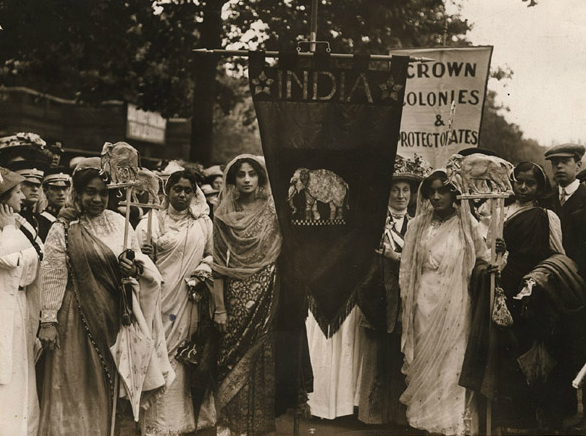
A plinth which features the names and portraits of 59 women and men who were central to the suffrage movement includes two women of colour and the leader of Jewish League for Woman Suffrage.
To mark the centenary of The Representation of the People Act, which gave women over 30 and “of property” the right to vote, the Mayor of London, Sadiq Khan, announced a unique exhibition in Trafalgar Square to honour the 59 names.
One of the names on this list is Sophia Duleep Singh (1876-1948). She was the daughter of Maharaja Duleep Singh, the last Maharaja of the Sikh Empire before its annexation by the British in 1849. Her godmother was Queen Victoria. Her grandfather was Ranjit Singh, who founded the Sikh Empire and was known as the ‘lion of the Punjab’.
Singh joined the movement for suffrage in 1909 and led a march to parliament with Emmeline Pankhurst on November 18, 1910, which became known as ‘Black Friday’ due to the violent actions of the police which resulted in the death of one suffragette, Ellen Pitfield.
The then Home Secretary Winston Churchill blocked any police investigation into the violence Singh herself witnessed and experienced, according to the journalist Anita Anand, who published Sophia: Princess, Suffragette, Revolutionary in 2015. This book thrust Singh’s life and activism from relative obscurity into deserved recognition.
Months later, and in another act of protest, she threw herself at the car of the then Prime Minister H.H. Asquith, on the day of the King’s speech to parliament in February 1911. Any charges against her were dropped to avoid further political embarrassment.
A photograph of Singh captures her selling copies of The Suffragette newspaper near her family home in Hampton Court Palace in 1913.
Fantastic to know that Sophia Duleep Singh will be on a stamp next month to mark 100 years since women over 30 got the vote in the UK. Possibly the first person of Sikh heritage on a British stamp. #vote100 #suffrage100 pic.twitter.com/S7gXTpXjD5
— City Sikhs (@citysikhs) January 11, 2018
This photograph will now feature on a stamp to mark the centenary of suffrage.
Singh joined the Tax Resistance League (WTRL). Her refusal to pay tax led to temporary confiscation of her jewellery, which was returned to her by other members of the WTRL.
She also raised awareness about the plight of Indian soldiers who fought in World War One.
The other woman of colour depicted in the plinth is Lolita Roy, who was president of the London Indian Union. She helped organise various ‘entertainment’ events to help fund the education of Indian women in England, according to Antoinette Burton. The proximity of other suffragettes like Jane Cobden Unwin, who attended events hosted by the Indian Union Society, did increase awareness among other suffragettes, as did the burgeoning networks of suffrage internationalism. Burton, however, describes how this form of internationalism was rooted in and dependent upon a ‘colonised form’ of womanhood. In short, Burton posits that women of colour became the useful props to showcase the vitality and universality of the British variant of suffrage which showcased ‘female colonial compliance’ abroad.
Nor was it an effort to reflect the diversity of the British population, according to Dr Sumita Mukherjee, a senior lecturer in history at the University of Bristol. For Dr Mukherjee, many suffragettes ‘mimicked’ the patronising discourse about the empire of race, which looked down upon the prospect of women abroad achieving suffrage before they did.
A photograph of Indian suffragettes at the Women’s Coronation Procession on June 17, 1911, was organised by Cobden Unwin, according to the Museum of London. Dr Mukherjee identified some of the women in the photo: Mrs P. L. Roy, Mrs Bhagwati Bhola Nauth, and Mrs Mukerjea.
Others, like the author and historian Jad Adams, have critiqued how the movement for suffrage for women in the UK borrowed the language of slavery.
During a speech in 1909, Millicent Fawcett posed the rhetorical question: “Why should the Maori women be in a superior position to that held by the women of England?” For Professor Raewyn Dalziel, of the University of Auckland, this question appealed to an audience ‘whose hierarchies firmly placed English women at the top.’
Henrietta (Netta) Franklin was a founding member of the Jewish League for Woman Suffrage (JLWS) and appears among the 59 names on the plinth. While remaining largely non-violent, members of the JLWS, both female and male, did much to raise awareness about universal suffrage – from awareness-raising events to political hunger strikes and even arson.
Netta Franklin also got involved in secular suffrage movements, having served as president of the National Union of Women Suffrage Societies in 1916 and 1917. According to the historian, Linda Gordon Kuzmack, the English suffragist movement held a ‘Christian-centric’ attitude and permitted only a few upper-class Anglo-Jewish women like Netta Franklin to leadership positions.
Other prominent Jewish women who played important parts in the suffrage movement include Eleanor Marx, Edith Zangwill, Lilian Montagu, and Inez Bensusan.
The plinth also goes to great lengths to recognise the role of working-class women.
Amber Rudd, the Home Secretary, has now agreed to consider pardons for jailed suffragettes, following campaigns from the Fawcett Society and some relatives of the suffragettes. The leader of the Conservatives in Scotland, Ruth Davidson, also supports the campaign, so does Jeremy Corbyn, the leader of the Labour Party.
The Equal Franchise Act of 1928 granted equal voting rights to women and men at the age of 21.
